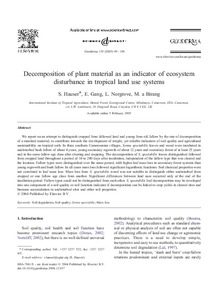| dc.contributor.author | Hauser, S. |
| dc.contributor.author | Gang, E. |
| dc.contributor.author | Norgrove, L. |
| dc.contributor.author | Birang, M. |
| dc.date.accessioned | 2019-12-04T11:18:54Z |
| dc.date.available | 2019-12-04T11:18:54Z |
| dc.date.issued | 2005 |
| dc.identifier.citation | Hauser, S., Gang, E., Norgrove, L. & Birang, M. (2005). Decomposition of plant material as an indicator of ecosystem disturbance in tropical land use systems. Geoderma, 129(1-2), 99-108. |
| dc.identifier.issn | 0016-7061 |
| dc.identifier.uri | https://hdl.handle.net/20.500.12478/3348 |
| dc.description.abstract | We report on an attempt to distinguish cropped from fallowed land and young from old fallow by the rate of decomposition of a standard material, to contribute towards the development of simple, yet reliable indicators of soil quality and agricultural sustainability on tropical soils. In three southern Cameroonian villages, Senna spectabilis leaves and wood were incubated in undisturbed bush fallow of about 4 years, young secondary regrowth of about 12 years and secondary forest of at least 25 years and in the same fallow age class after clearing and cropping. The decomposition of S. spectabilis leaves distinguished fallowed from cropped land throughout a period of 14 to 280 days after incubation, independent of the fallow type that was cleared and the location. Fallow types were distinguished over the same period, with higher leaf mass loss in secondary forest systems than young regrowth and bush fallow. In all cases mass loss followed significant logarithmic functions. Soil chemical properties were not correlated to leaf mass loss. Mass loss from S. spectabilis wood was not suitable to distinguish either undisturbed from cropped or one fallow age class from another. Significant differences between land uses occurred only at the end of the incubation period. Fallow types could not be distinguished from each other. S. spectabilis leaf decomposition may be developed into one component of a soil quality or soil function indicator if decomposition can be linked to crop yields in cleared sites and biomass accumulation in undisturbed sites and other soil properties. |
| dc.language.iso | en |
| dc.subject | Soil Degradation |
| dc.subject | Soil Quality |
| dc.subject | Senna Spectabilis |
| dc.subject | Mass Loss |
| dc.subject | Fallow |
| dc.subject | Decomposition |
| dc.title | Decomposition of plant material as an indicator of ecosystem disturbance in tropical land use systems |
| dc.type | Journal Article |
| dc.description.version | Peer Review |
| cg.contributor.affiliation | International Institute of Tropical Agriculture |
| cg.coverage.region | Africa |
| cg.coverage.region | Central Africa |
| cg.coverage.country | Cameroon |
| cg.authorship.types | CGIAR single centre |
| cg.iitasubject | Soil Health |
| cg.iitasubject | Soil Fertility |
| cg.iitasubject | Soil Information |
| cg.iitasubject | Knowledge Management |
| cg.iitasubject | Disease Control |
| cg.iitasubject | Farm Management |
| cg.iitasubject | Farming Systems |
| cg.iitasubject | Plant Production |
| cg.iitasubject | Integrated Soil Fertility Management |
| cg.accessibilitystatus | Limited Access |
| local.dspaceid | 95022 |
| cg.identifier.doi | https://dx.doi.org/10.1016/j.geoderma.2004.12.037 |

